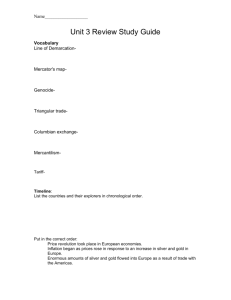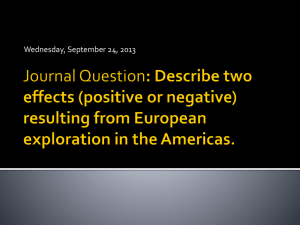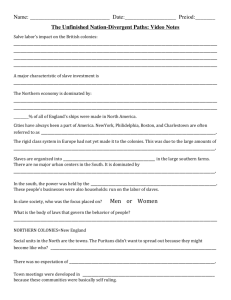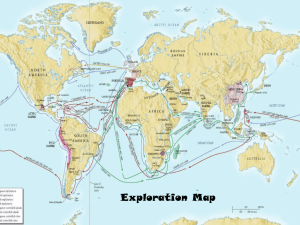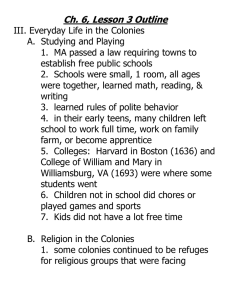Madison Public Schools 4th Grade Social Studies
advertisement
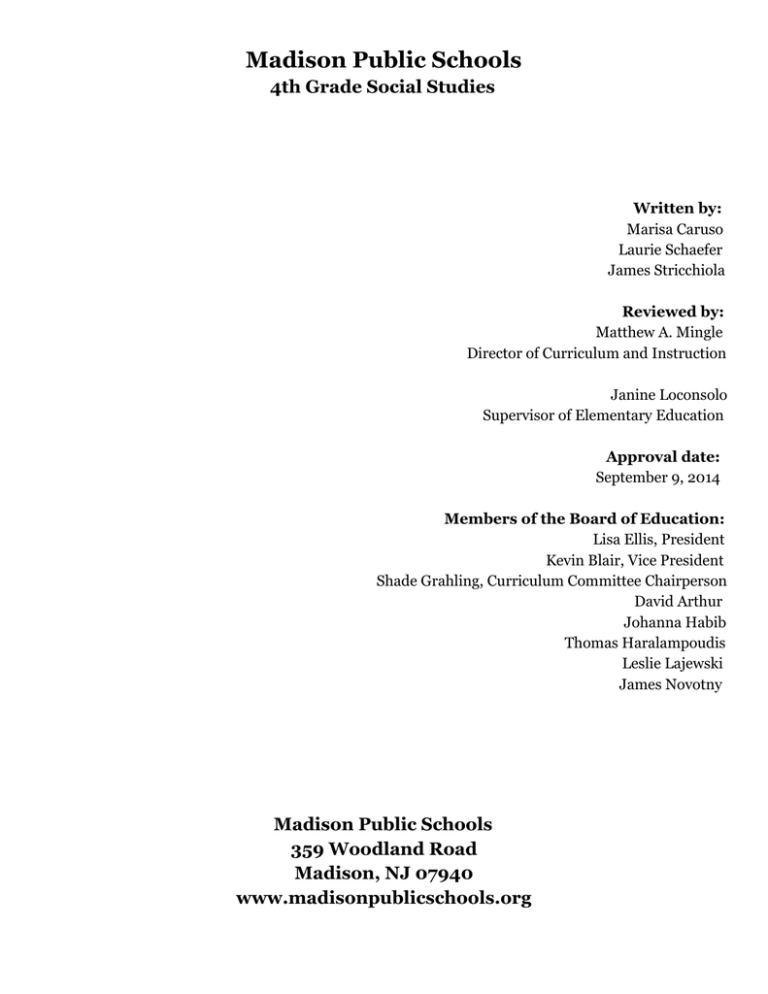
Madison Public Schools 4th Grade Social Studies Written by: Marisa Caruso Laurie Schaefer James Stricchiola Reviewed by: Matthew A. Mingle Director of Curriculum and Instruction Janine Loconsolo Supervisor of Elementary Education Approval date: September 9, 2014 Members of the Board of Education: Lisa Ellis, President Kevin Blair, Vice President Shade Grahling, Curriculum Committee Chairperson David Arthur Johanna Habib Thomas Haralampoudis Leslie Lajewski James Novotny Madison Public Schools 359 Woodland Road Madison, NJ 07940 www.madisonpublicschools.org Course Overview Description The fourth grade Social Studies course of study begins with investigating the motivation for European exploration. It will transition into the colonization of the New World. It will conclude with studying the tension that grew between the colonies and Great Britain. Goals This course aims to: ● Apply non-fiction reading strategies to understand the effects of exploration and colonization of the New World. ● Understand the role slaves had in the colonies. ● Determine the reasons for and the events leading up to the creation of the Declaration of Independence. ● Engage students in a variety of activities, such as writing, role playing, debating, drawing,and problem solving, as a means to learning the content of the units. Resources Suggested activities and resources page Unit 1 Overview Unit Title: Exploration Unit Summary: Students will learn how and why explorers set out for the new world in the late 1400s and 1500s. Furthermore, they will learn about European explorers who claimed land in North America. Students will synthesize by ranking each explorer’s impact on history. Suggested Pacing: 15 lessons Learning Targets Unit Essential Questions: ● Why do people seek new lands? ● How did European exploration impact the New World? Unit Enduring Understandings: ● Europeans had different motives for wanting to leave their homelands. Their desires and discoveries impacted the New World in various ways. Evidence of Learning Unit Benchmark Assessment Information:Explorer impact on history assessment- page 32 timeline Exploration Benchmark Assessment Rubric for Benchmark Assessment Objectives (Students will be able to…) Describe what explorers took to and from the New World during the Age of Exploration. Identify motives for exploration of the New World. Essential Content/Skills Content: New World, Age of Exploration, explorer, archaeologist, astrolabe, the Americas, cash-crop, nation-state Skills: Suggested Assessments Formal Assessment-chapter 4 (see lesson masters book) Journal Entry-Interactive Student Notebook pg 25 Identify tools for exploration. Standards (NJCCCS CPIs, CCSS, NGSS) 6.1.4.C.2 Distinguish between needs and wants and explain how scarcity and choice influence decisions made by individuals, communities, and nations. Pacing 5 lessons 6.1.4.C.9 Compare and contrast how access to and use of resources affects people across the world differently. 6.1.4.C.16 Explain how creativity and innovation resulted in scientific achievement and inventions in many cultures during different historical periods. Imagine traveling without access to tools. Examine objects from an explorer’s ship. 6.1.4.D.19 Explain how experiences and events may be interpreted differently by people with different cultural or individual perspectives. Categorize navigation tools. W.4.3 Write narratives to develop real or imagined experiences or events using effective technique, descriptive details, and clear event sequences. Explain the impact exploration of the New World had on the natives. Content: conquistador, Northwest Passage, contagious disease, East Indies, colony Explain how the exploration of the Americas led to settlement. Christopher Columbus, John Cabot, Juan Ponce De Leon, Hernan Cortes, Jacques Cartier, Francisco Coronado, Henry Hudson Samuel De Champlain, Robert La Salle Skills: Identify, organize, and analyze key facts about eight early European explorers who led expeditions to the New World. Trace and label explorers’ routes and identify the motives for the explorations of early European explorers. Predict the level of impact European explorers had on Formal AssessmentChapter 5 (see lesson masters book) Explorer MatrixInteractive Student Notebook pg 28-29 6.1.4.D.1 Determine the impact of European colonization on Native American populations, including the Lenni Lenape of New Jersey 6.1.4.D.2 Summarize reasons why various groups, voluntarily and involuntarily, immigrated to New Jersey and America, and describe the challenges they encountered. 6.1.4.D.3 Evaluate the impact of voluntary and involuntary immigration on America’s growth as a nation, historically and today. 6.1.4.D.4 Explain how key events led to the creation of the United States and the state of New Jersey. 4.RI.7 Interpret information presented visually, orally, or quantitatively (e.g., in charts, graphs, diagrams, time lines, animations, or interactive elements on Web pages) and explain how the information contributes to an understanding of the text in which it appears. 6 lessons North American history. Unit 2 Overview Unit Title: Early Colonization Unit Summary: Students will learn about the opportunities that presented themselves to settlers embarking on life in the New World. Students will recognize and distinguish the similarities and differences between life in the three early English Settlements as well as the original colonies. Students will come to understand the challenges that faced the early colonists and why certain settlements succeeded and others failed. Suggested Pacing: 13 lessons Learning Targets Unit Essential Questions: ● How did the challenges faced by the first English settlers affect the shaping of the colonies in the New World? ● How do different groups of people learn from one another? ● In what ways were the early settlements alike? Different? Unit Enduring Understandings: ● People in each colony used the colony’s unique resources to overcome the challenges they were presented with. They capitalized on their resources in order to prosper. Evidence of Learning Unit Benchmark Assessment Information: Suppose that you are moving from Great Britain to one of the North American colonies in the 1740’s. Write a farewell letter to your family. Your letter should include: ● A date and salutation ● Paragraph(s) that identify the colony in which you plan to settle and then explains your reasons for moving there. ● Paragraph(s) that compare your choice of colony with the two other regions of colonial America (for example, if you were to choose Georgia- a southern colony- you would compare it with the New England and Middle regions) ● Writing that has a clear voice that is appropriate for the time period and is free from spelling and grammatical errors. This assessment is based on a writing prompt in the interactive student notebook, pg. 43s. Objectives (Students will be able to…) Explain the challenges the first English colonies faced. Explain why some English settlements survived, while others did not. Essential Content/Skills Content:settlement, Roanoke, Jamestown, Plymouth, marsh, colonist, democratic, ally Skills: Suggested Assessments Formal AssessmentChapter 6 (see lesson masters book) Advertisement for a particular settlementInteractive Student Notebook pg 38 Compare and contrast the three English settlements of Roanoke, Jamestown, and Plymouth Standards (NJCCCS CPIs, CCSS, NGSS) 6.1.4.B.4 Describe how landforms, climate and weather, and availability of resources have impacted where and how people live and work in different regions of New Jersey and the United States. Pacing 6 lessons 6.1.4.D.1 Determine the impact of European colonization on Native American populations, including the Lenni Lenape of New Jersey. 6.1.4.D.5 Relate key historical documents (i.e., the Mayflower Compact, the Declaration of Independence, the United States Constitution, and the Bill of Rights) to present day government and citizenship. Locate settlements on a map. Analyze the causes and effects of events before and during King Philip’s War. 6.1.4.D.19 Explain how experiences and events may be interpreted differently by people with different cultural or individual perspectives. 4.RI.3 Explain events, procedures, ideas, or concepts in a historical, scientific, or technical text, including what happened and why, based on specific information in the text. 4.W.1 Write opinion pieces on topics or texts, supporting a point of view with reasons and information. Identify the similarities and differences among the three colonial regions. Content: economy, plantation, indentured servant, industry, West Indies, grant, assembly, apprentice Skills: Identify key features of six colonies: Massachusetts Bay, Rhode Island, New York, Pennsylvania, Maryland, and Georgia. Gather and organize information about a colony into a persuasive presentation. Compare and contrast the New England, Middle, and Southern Colonies through charts and writing. Formal AssessmentChapter 7 (see lesson masters book) Completed Chart on 6 colonies- Interactive Student Notebook pg 40-41 6.1.4.A.1 Explain how rules and laws created by community, state, and national governments protect the rights of people, help resolve conflicts, and promote the common good. 6.1.4.C.2 Distinguish between needs and wants and explain how scarcity and choice influence decisions made by individuals, communities, and nations. 6.1.4.C.5 Explain the role of specialization in the production and exchange of goods and services. 6.1.4.D.1 Determine the impact of European colonization on Native American populations, including the Lenni Lenape of New Jersey. 6.1.4.D.2 Summarize reasons why various groups, voluntarily and involuntarily, immigrated to New 6 lessons Jersey and America, and describe the challenges they encountered. Draw conclusions from a map. 4.W.2 Write informative/explanatory texts to examine and convey complex ideas and information clearly and accurately through the effective selection, organization, and analysis of content. 4.SL.4 Engage effectively in a range of collaborative discussions (one-on-one, in groups, and teacher-led) with diverse partners on grade 4 topics and texts, building on others' ideas and expressing their own clearly. Optional: Describe life in Colonial Williamsburg. Chapter 9 Content: Williamsburg, capitol, craftsmen, trades, politics, royal colony, bills Skills: Identify important sites in colonial Williamsburg. Describe aspects of life in colonial Williamsburg: education, trades, social life, government, slavery, and religion. Compare and contrast life in colonial Williamsburg with life in the students’ community. Interactive Student Notebook pg 120-121 6.1.4.D.2 Summarize reasons why various groups, voluntarily and involuntarily, immigrated to New Jersey and America, and describe the challenges they encountered 6.1.4.D.3 Evaluate the impact of voluntary and involuntary immigration on America’s growth as a nation, historically and today. 6.1.4.D.14 Trace how American identity evolved over time. 3 lessons Unit 3 Overview Unit Title: Slavery Unit Summary: Students will understand what enslaved Africans had to endure on their journey to the New World and what life was like for slaves living in the colonies. Students will also understand how the slave trade linked Europe, Africa, and the Americas. Suggested Pacing: 9 lessons Learning Targets Unit Essential Questions: ● What factors contributed to the slave trade? ● How did the trading of certain goods between the Europeans and the West Africans promote the slave trade? ● What effect did the slave trade have on West African cultures? ● How did previous explorations by European explorers inadvertently promote the slave trade? ● How was the triangular trade an almost unbreakable cycle? ● How did some slaves manage to survive the ordeal of the Middle Passage and in the daily life as an enslaved African American manage to find hope and comfort? Unit Enduring Understandings: ● People throughout history have been exploited. Supply, demand and most of all greed have caused hardships. Throughout this, people have managed to survive and find hope. Evidence of Learning Unit Benchmark Assessment Information: Use interactive notebook pg. 46- Critical thinking A. Students should work in groups to debate, then individually choose one option to support in written form. Objectives (Students will be able to…) Understand the similarities and differences amongst West Africans. Explain dilemma 1: Trading slave for guns in West Africa. Explain dilemma 2:Surviving the Middle Passage Explain dilemma 3: Living as a slave in the colonies. Describe ways that slaves kept hope alive. Essential Content/Skills Content: dilemma, Middle Passage, Triangular trade, slave auction, overseer, Griot, spiritual Map Skills: Geography of West Africa, Timeline, Societal structure of West Africans, Slave Trade Skills: Locate West Africa. Define Slave Trade. Define and apply term dilemma to slavery. Describe daily life in West African Village. Identify the struggles of surviving the Middle passage. Describe slave life in the colonies: the choices, building a culture and keeping memories alive. Suggested Assessments Formal AssessmentChapter 8 (see lesson masters book) Journal Entry pg. 50 Interactive student notebook Standards (NJCCCS CPIs, CCSS, NGSS) 6.1.4.D.9 Explain the impact of trans-Atlantic slavery on New Jersey, the nation, and individuals. 6.1.4.D.13 Describe how culture is expressed through and influenced by the behavior of people. 6.1.4.D.15 Explain how various cultural groups have dealt with conflict between maintaining traditional beliefs and practices and adopting new beliefs and practices. 4.W.2 Write informative/explanatory texts to examine a topic and convey ideas and information clearly. Pacing 8 lessons Unit 4 Overview Unit Title: Tensions Arise Unit Summary: This unit focuses on the reasons why Americans sought independence from Britain and how the colonists responded to the British government’s desire to gain greater control over the colonies. Suggested Pacing: 17 lessons (Begin during marking period 3) Learning Targets Unit Essential Questions: ● How is power justified? ● How do societies resolve conflict? ● How can individuals make a difference in society? In history? Unit Enduring Understandings: ● People view power differently and base their actions accordingly. ● The resolution of conflict may involve aggression, compromise, cooperation, and change. Not everyone will be happy with the outcome. ● People respond to conflicts in a variety of ways. People react to what is important to them based on own experiences and a desire to change a situation. Evidence of Learning Unit Benchmark Assessment Information: Objectives (Students will be able t0…) Explain what British actions angered the colonists in the 1700s. Describe the importance of the French and Indian War and the resulting Proclamation of 1763. Essential Content/Skills Content: Ohio River Valley, the fur trade with American Indians, British gain land in North America, British debts, British designates newly won land for American Indians Suggested Assessments Create a news article that describes the events of the war and the effects of the British victory Skills: Identify the causes of the war and name countries involved. 4 lessons 6.1.4.D.4 Explain how key events led to the creation of the United States of America. Pull key information from informational texts. Skills: Define domain specific vocabulary. 9.1.4.A.1 Recognize a problem and brainstorm ways to solve the problem individually or collaboratively. 6.3.4.D.1 Identify actions that are unfair or discriminatory, such a bullying, and propose solutions to address such actions. Compare and contrast British owned land before and after the war. Content: The Quartering Act, the Sugar Act, the Stamp Act, The Stamp Act Congress, Sons of Liberty, Boston Massacre, Boston Tea Party, Intolerable Acts, First Continental Congress, “No taxation without Representation”, Parliament Pacing 6.3.4.A.1 Evaluate what makes a good rule or law. Locate areas/boundaries on map. Describe the causes and effects of the British tax acts and the Intolerable Acts. Standards (NJCCCS CPIs, CCSS, NGSS) 6.1.4.A.9 Compare and contrast responses of individuals and groups, past and present, to violations of fundamental rights. Complete cause and effect chart to show why British laws were created and how colonists responded. Create a timeline of important events (British laws,Boston Tea Party, etc.). Formal AssessmentChapter 10 (see lesson masters book) 6.1.4.A.1 Explain how rules and laws created by community, state and national governments protect the rights of people, help resolve conflicts, and promote the common good. 5 lessons 6.1.4.c.4 Describe how supply and demand influence price and output of products. List and identify main ideas of British Laws. Pull key information from informational texts. Explain the arguments for and against colonial independence from Great Britain. Compare and Contrast the views Content: independence, Loyalists, Patriots, neutral, traitor, tyrant, treason, resolution, King George, Parliament Skills: Chart explaining Patriot and Loyalist arguments for or against independence Letter Writing Activity pg 65-66 Interactive Student Notebook 6.1.4.D.19 Explain how experiences and events may be interpreted differently by people with different cultural or individual perspectives. 3 lessons of Loyalists and Patriots. Compare and contrast opinions of Loyalists and Patriots. Identify people who shared loyalist and patriot views. Read, interpret, and paraphrase opinions of Patriots and Loyalists. Describe and analyze the contributions of specific individuals and groups of people in the American colonies. Content: Benjamin Franklin, Samuel Adams, Patrick Henry, Mercy Otis Warren, John Adams, the Committees of Correspondence, the Continental Congress Interview one of the individuals learned about (compose 5 questions/answers that indicate understanding of person’s actions/opinions) Skills: Pull key information from informational texts. Formal AssessmentChapter 11 (see lesson masters book) Research on internet to find facts about specific individuals. Read, interpret, and paraphrase key lines from Patrick Henry’s speech. Support ideas with facts/evidence from text. 8.1.4.E.1 Evaluate the accuracy of, relevance to, and appropriateness of using print and non-print electronic information sources to complete a variety of tasks. 5 lessons

